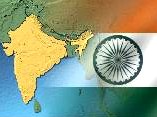


All You Need to
Know About INDIA
Government
Politics
Administrative divisions
Geography
Economy
Demographics
Culture
Last updated on
Sunday, October 29, 2006 19:28
- Mac. Dream. MX
India is referred to as the largest democracy in the world, by virtue of the fact that it has the largest electing population among democratic countries. The country has a federal form of government and a bicameral parliament operating under a Westminster-style parliamentary system. It has three branches of governance: the Legislature, Executive and Judiciary. The President is the head of state, though he has a largely ceremonial role to play. He is also the Supreme Commander of India's armed forces. The President is elected indirectly by an electoral college for five-year terms. Presidential assent is needed for a Bill or Ordinance passed by the Parliament to come into force. The Prime Minister is the de facto head of government, and has most executive powers. He or she is appointed by the President, with the requirement that he or she enjoy the support of the party or coalition having more than 50% seats in the lower house. The Union Council of Ministers headed by the Prime Minister aids and advises the President on governance matters.
The Secretariat Building in New Delhi houses the Prime Minister's Office, the ministries of Defence, External Affairs and Finance and the Home Ministry
The legislature of India is the bicameral Parliament, which consists of the upper house called the Rajya Sabha (Council of States), and the lower house called the Lok Sabha (House of People). The 245-member Rajya Sabha is chosen indirectly through the state Legislative Assemblies, and has a staggered six-year term. Each state sends members to the Rajya Sabha in a proportion of its population. The 545-member Lok Sabha is directly elected (Some seats are reserved for Caste based system) by popular vote for a five-year term (except two nominated Anglo-Indian members), and is the determinative constituent of political power and government formation. Universal adulthood suffrage is guaranteed by the Constitution for citizens above 18 years of age. The executive arm consists of the President, Vice-President, and the Council of Ministers (the Cabinet being its executive committee) headed by the Prime Minister. Any minister holding a portfolio must be a member of either house of parliament. In the Indian parliamentary system, the executive is subordinate to the legislature.
India's independent judiciary consists of the Supreme Court, headed by the Chief Justice of India. The Supreme Court has both original jurisdiction over disputes between states and the Centre, and appellate jurisdiction over the eighteen High Courts of India, and additionally, the power to declare Union and state laws null and void if in conflict with the Constitution.
| Flag | Tiranga |
| Emblem | Sarnath Lion |
| Anthem | "Jana Gana Mana" |
| Song | "Vande Mataram" |
| Animal | Royal Bengal Tiger |
| Bird | Indian Peacock |
| Flower | Lotus |
| Tree | Banyan |
| Fruit | Mango |
| Sport | Field Hockey |
| Calendar | Saka |
National symbols of India
Terms
of Service, Privacy
Policy, Contacts and Credits
© 2006 thanneer91. All rights reserved
Page tested with Internet Explorer and Mozilla Firefox
Best viewed at a resolution of 600 X 800
Any unauthourized duplication of this site is strictly prohibited and liable
to prosecution
Timeline of Indian History ~~ Military History of India ~~ Indian Independance Movement